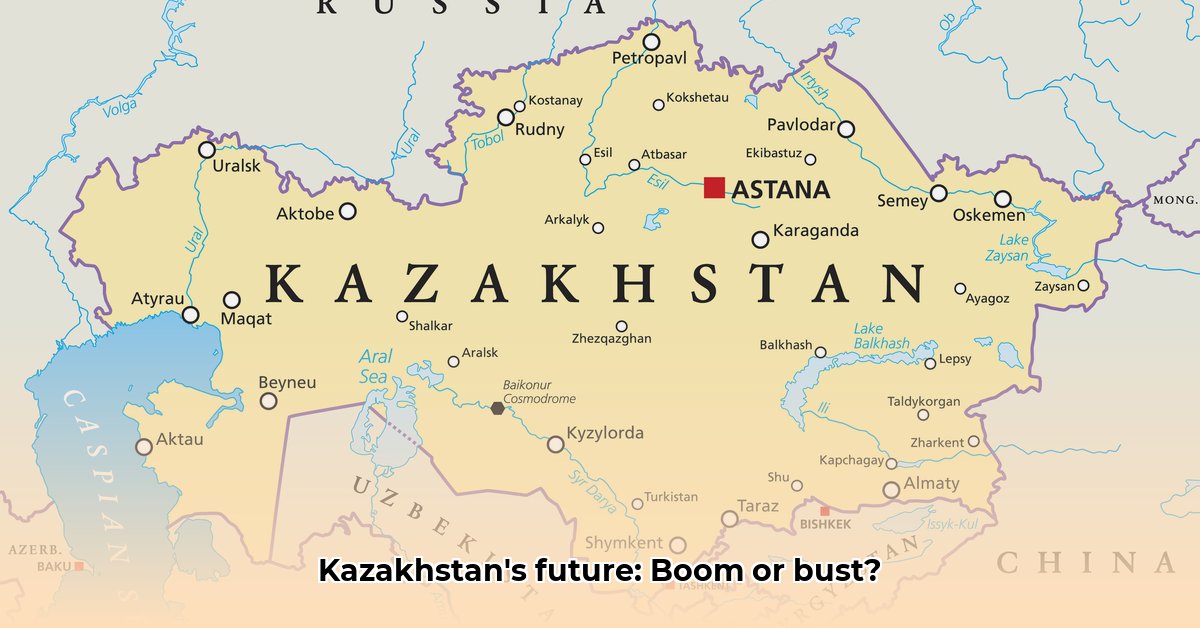
Kazakhstan: A Nation at a Crossroads
A Land of Nomads, Soviets, and Now?
Picture a country bigger than Western Europe, stretching across the vast steppes and soaring mountains of Central Asia. That's Kazakhstan – a land with a history as rich and varied as its landscape. From nomadic tribes traversing the Silk Road to the era of Soviet control, Kazakhstan's past has shaped its present. Independence in 1991 brought newfound freedom, but also the monumental task of building a market economy and navigating the complexities of a post-Soviet world. This journey, filled with both immense potential and significant hurdles, is a story of adaptation and ambition.
A Geopolitical Tightrope Walk
Kazakhstan's strategic location presents both opportunities and challenges. Sandwiched between global powers Russia and China, its geopolitical position demands a delicate balancing act. Membership in organizations like the Eurasian Economic Union (EAEU) and the Shanghai Cooperation Organisation (SCO) further complicates this already intricate dance. How can Kazakhstan maintain its independence while fostering economic ties with its powerful neighbours? This question lies at the heart of its foreign policy. The diverse ethnic makeup of its population adds another layer of complexity to this delicate balancing act.
Oil and Beyond: A Quest for Economic Diversity
For years, Kazakhstan's economy has been heavily reliant on oil and gas exports. But this dependence creates vulnerability. What happens when global oil prices fluctuate? The nation is acutely aware of this risk and is actively pursuing economic diversification, investing in sectors such as tourism and technology. This transition requires significant investment and long-term commitment. Can Kazakhstan successfully transform its economy and reduce its dependence on volatile commodity markets? The answer will shape its future prosperity.
An Environmental Wake-Up Call: The Aral Sea's Warning
The shrinking Aral Sea stands as a stark reminder of the environmental consequences of rapid industrialization. Decades of intensive irrigation and resource extraction have dramatically altered the landscape. This ecological catastrophe serves as a cautionary tale, highlighting the urgent need for sustainable development practices. Can Kazakhstan balance its economic aspirations with environmental protection? This question is not just about preserving the environment but also ensuring long-term economic and social well-being.
Political Power: A Balancing Act
Kazakhstan's political system presents a unique dynamic. Often described as authoritarian, the nation has embarked on various reform initiatives. However, the balancing act between maintaining stability and fostering democratic progress remains a significant challenge. Recent political developments have further underscored the complexities of this path. How can Kazakhstan reconcile its commitment to stability with the aspirations for a more inclusive and democratic future? This question will shape its political trajectory for years to come.
Kazakhstan's Future: A Roadmap Under Construction
Kazakhstan's future hinges on its ability to navigate three interconnected challenges: reducing its dependence on oil, enhancing environmental sustainability, and promoting political inclusivity. Each of these requires careful strategic planning, substantial investment, and a commitment to meaningful change. The road ahead is uncertain yet brimming with both risks and opportunities. Its success – or failure – will have broader implications for other resource-rich nations striving for sustainable development.
How to mitigate environmental risks in Kazakhstan's resource extraction
Balancing Development and the Environment: Kazakhstan's Resource Dilemma
Kazakhstan’s economic growth is strongly tied to its abundant natural resources. But this dependence carries significant environmental risks. The 2024 floods, costing a staggering 300 billion tenge, dramatically underscored the necessity for effective climate adaptation strategies. This highlights the urgent need to find a balance between development and environmental protection.
The National Adaptation Plan (NAP): A Roadmap for Resilience
Recognising these challenges, Kazakhstan has developed a National Adaptation Plan (NAP) to integrate climate resilience into its development strategy. This proactive approach focuses on regional variations in climate change impacts, acknowledging the diversity of challenges across the country’s vast territory. The plan addresses key sectors such as agriculture, forestry, and water management. Its success, however, relies heavily on strong governmental commitment, international collaborations (like those with the UNDP and Green Climate Fund), and active private sector and community involvement.
Key Sectors and Collaboration: A Multi-Stakeholder Approach
The NAP’s success hinges on effective collaboration between various stakeholders. Government agencies, the private sector, and local communities must work together to ensure its proper implementation. This collaborative approach is vital to address the multifaceted nature of the climate change challenge. The plan also prioritizes sustainable resource management, aiming to minimise environmental damage while promoting economic progress.
Funding and Implementation: Overcoming the Hurdles
Securing sufficient funding and ensuring effective implementation remain crucial obstacles. Robust monitoring and evaluation mechanisms are vital to ensure accountability and track progress. Without transparent oversight, the NAP risks becoming just another well-meaning but ultimately ineffective policy document.
How to mitigate environmental risks in Kazakhstan's resource extraction: A Practical Approach
Successful mitigation of environmental risks requires a multi-pronged approach:
- Sustainable Extraction Practices: Enforcing stricter environmental regulations in mining, oil, and gas extraction, focusing on waste reduction, improved efficiency, and cleaner technologies.
- Investing in Green Technologies: Actively promoting research, development, and adoption of environmentally friendly extraction methods through financial incentives and strategic partnerships.
- Strengthening Environmental Monitoring: Implementing a comprehensive monitoring system to detect and address environmental impacts promptly.
- Community Engagement: Actively involving local communities in environmental protection efforts to foster a sense of ownership and responsibility.
- International Cooperation: Collaborating with international organizations and other countries to leverage best practices and advanced technologies.
The Path Forward: Opportunities and Risks
The journey towards sustainable development in Kazakhstan is fraught with both risks and opportunities. Insufficient funding, weak stakeholder engagement, and implementation gaps pose significant threats. However, the successful implementation of the NAP offers a chance to achieve economic prosperity while building a more resilient and environmentally sound future. The path forward requires clear vision, strong commitment, and coordinated action.